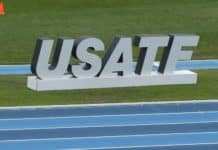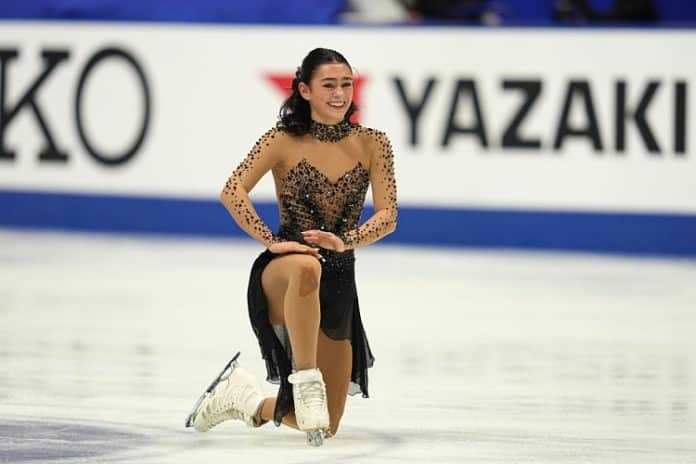★ The Sports Examiner: Chronicling the key competitive, economic and political forces shaping elite sport and the Olympic Movement.★
★ To get The Sports Examiner by e-mail: sign up here! ★
≡ THE 5-RING CIRCUS ≡
1. USA Track & Field reserves down to $597,993 at start of 2023
2. More Tokyo 2020 questions: bid gift inquiry asked
3. USA Swimming: no contact with Russian federation
4. WADA’s 2022 annual report: 87% of aths trust the system
5. European study shows anti-doping education has impact
● USA Track & Field posted its 2022 tax return, showing that a long-promised $9.9 million contribution was made to the organizing committee of the 2022 World Athletics Championships in Eugene, running its reserves down to $597,933 at the start of this year. Both revenues and expenses set all-time records, with the annual loss at $6.72 million.
● The Tokyo 2020 Olympic bid is in the headlines again after a Prefectural Governor said that undisclosed government funds were used to enable “gifts” for International Olympic Committee members prior to the 2013 where Tokyo won the right to stage the Games. Prime Minister Kishida was asked to open an inquiry.
● USA Swimming said it has had no discussions with the Russian Swimming Federation about a dual meet next February, following the 2024 World Aquatics Championships in Qatar, as Russian federation head Vladimir Salnikov had claimed over the weekend.
● The World Anti-Doping Agency published its annual report for 2022, noting that a survey of more than 1,500 athletes had 87% saying that they “trust that the anti-doping system enables clean competition and fair play.” The IOC and European governments continue to be the main WADA funders.
● An Italian-led study of the European Athletics mandatory “I Run Clean” education program showed that attitudes towards doping fell by 11% among athletes surveyed and 38% among coaches, a considerable success.
● Panorama: International Olympic Committee (“targeted dialogue” explained) = Paris 2024 (airports, Seine River to be closed for Olympic opening) = Athletics (Russian doping reported down in 2023) = Alpine Skiing (Shiffrin’s unbelievable career Slalom record) = Bobsled & Skeleton (IBSF celebrates its centennial) = eSports (Saudi prince elected head of IESF) = Fencing (FIE Congress recognizes year’s best) = Sailing (“Olympic Vision” concepts may include new rankings system) ●
1.
USA Track & Field reserves down to $597,993 at start of 2023
At the end of 2021, USA Track & Field reported net reserves of $8,533,319 on its IRS Form 990, the required tax return for non-profit organizations.
On Monday, nearly 11 months after the end of the year, the federation posted its 2022 Form 990, showing its net reserves were down by 93.0% to $597,993, after an overall loss of $6.72 million.
Why? A long-promised cash contribution to the success of the 2022 World Athletics Championships in Eugene of $9,903,723. A note on the cover of the return states this clearly, and it has left USATF with a difficult financial tightrope to walk, moving into an Olympic year with modest resources available to support its athletes, teams and programs. Compared with 2021:
● Assets were down from $46.08 million to $34.27 million, the lowest since 2013, when Nike’s sponsorship to 2040 was agreed.
● Cash available was down from $13.40 million to $1.80 million.
● Revenues were up from $33.77 million to $37.94 million, the most ever in a single year, which makes sense with the Worlds in the U.S. for the first time.
● Expenses were up from $34.14 million to $44.66 million, due to the World Championships payment, easily the highest expense total in USATF history (the prior high was $38.43 million in 2016).
There was a helpful increase in sponsorships in 2022 – helpful in a year when the U.S. hosted the Worlds – and extra donations to help ease some of the pain:
● Donations: $5.92 million in 2021, up to $7.95 million in 2022.
● Sponsorships: $20.21 million in 2021, rising to $23.30 million in 2022.
● Event rights and tickets: $3.94 million in 2021, down to $1.02 million in 2022.
● Membership fees: $1.428 million in 2021, up to $2.19 million in 2022.
● Sanction fees: $586,728 in 2021, nicely up to $1.06 million in 2022.
● Media revenue: $941,520 in 2021, up to $1.46 million in 2022.
The donations total included a “government grant” of $1.06 million and $3.88 million in in-kind goods and services, including apparel and other gear from Nike and a lot of airline credits.
The tax statement also detailed the amounts paid to athletes and volunteers:
● $2.52 million in prize money, to 670 athletes.
● $1.06 million in World Championships athlete payments (to 141).
● $406,580 in athlete travel funding (to 217).
● $312,467 in athlete travel funding (to another 400).
● $1.11 million in non-cash athlete travel support (to the 400).
● $748,000 in coaching stipends (to 90).
● $2.17 million staff/volunteer travel support (to 1,500).
As far as staff, 11 members of the 97 employees were shown with compensation of more than $100,000. Chief executive Max Siegel, who recently received a five-year contract extension, received $1.31 million for 2022, and has $405,347 remaining on a $952,730 loan he received from USATF to cover tax liabilities on his bonus shown in 2021 related to the long-term Nike sponsorship contract. USATF still owes $12.58 million in other commissions related to that sponsorship.
The organization’s cash was low and USATF had used $5.8 million of an $8.0 million line of credit as of the end of 2021. It maintains investments of $9.90 million as of the end of 2022.
More information may be available in the federation’s audited financial statement, expected to also be released this week, as the USATF Annual Meeting will be held from Thursday through Sunday in Florida.
Observed: USATF’s commitment to funding for the 2022 Worlds in Eugene was going to hurt its finances badly, and it did. Money is tight, and track & field is well behind other U.S. National Governing Bodies such as USA Swimming ($67.87 million in assets in 2022 and $41.28 million in reserves), the U.S. Soccer Federation ($171.7 million in assets in 2022 and $108.3 million in reserves) and U.S. Ski & Snowboard, which showed $99.56 million in assets and reserves of $75.44 million as of 30 April 2023.
2.
More Tokyo 2020 questions: bid gift inquiry asked
Scandal continues to dog the Tokyo 2020 Olympic Games, with prosecutions continuing over bid-rigging of test events and venue management contracts and bribes over sponsorship selections, and now questions in the Diet (parliament) over gifts to members of the International Olympic Committee.
Tokyo was elected in 2013 by 60-36 over Istanbul (TUR) in the second round of voting, and Hiroshi Hase, a former Diet member and now the governor of the Ishikawa prefecture in central Japan said on 17 November that he was asked by then-Prime Minister Shinzo Abe “to make sure we win” and assuring Hase that there was money available for campaigning from Cabinet Secretariat discretionary funds, which are not made public. Per Kyodo News:
“Hase said he created albums costing 200,000 yen ($1,342) each for about 100 IOC members, containing photos from their athletic careers and other relevant information, while saying he ‘traveled around the world with the gifts.’”
Such items would be a breach of the IOC’s Ethics Code and could constitute a mis-use of the Cabinet Secretariat budget. Hase issued a statement about his comments, saying “They were statements based on facts that I had misunderstood, and I have fully retracted it,” and explained that he had been contacted by the Education Ministry, which pointed to mistakes in his original comment.
But that did not stop opposition politicians from asking current Prime Minister Fumio Kishida about the gifts and for an investigation on Monday (27th). Kishida responded:
“I would like to think about concrete responses after carefully considering the circumstances surrounding the retraction.”
While the gifts as described are a far cry from the outright bribery of IOC members that was alleged for the election of Rio de Janeiro for 2016, gifts of varying kinds had become part of the winner-takes-all bid fracas that has marked elections of bids for Olympic Games held in the 21st Century. The IOC reformed the process in 2019, ending direct elections and creating the current “dialogue” process through appointed Future Host Commissions for the summer and winter Games.
Japanese media saw Hase’s comments as a blow to the credibility of the ruling Liberal Democratic Party. And it does not help discussions about a future Winter Games bid for Sapporo, likely now a possibility in 2038 at the earliest.
3.
USA Swimming: no contact with Russian federation
A Saturday post by the Russian news agency TASS quoted Russian Swimming Federation chief Vladimir Salnikov thus:
“I approached the U.S. Swimming Federation about holding a match meeting immediately after the world championships in Doha [in February 2024]. Now they are considering this proposal, but some people with whom I spoke, including the legendary American coach Mark Schubert, were very positive.
“As soon as we make progress in this direction, we will make an official statement.”
Asked for details on Monday, USA Swimming Chief Commercial Officer Shana Ferguson wrote in an e-mail:
“I can confirm to you that the leadership of USA Swimming has not spoken to the Russian Swimming Federation about this matter.”
The idea didn’t make a lot of sense in any case, as the U.S. is sending only 18 swimmers to Doha next February – including just five women – well short of the maximum team size of 52 and way short of the number required for a dual meet.
4.
WADA’s 2022 annual report: 87% of aths trust the system
One of the reasons that the World Anti-Doping Agency was founded in 1999 was to re-establish trust in Olympic sport that athletes are competing on a “level playing field” vis-a-vis doping.
That goal is being met, according to the 2022 WADA Annual Report, released on Friday (24th), as 87% of the 1,541 athletes surveyed “trust that the anti-doping system enables clean competition and fair play.”
The report also noted that surveys showed 74% of athletes believed that WADA “is concerned about athlete welfare” and 68% felt that WADA was interested in their needs and “is fair when dealing with athletes.”
WADA also won a grant of €1.43 million (about $1.56 million U.S.) to expand its investigational capabilities, an increasingly important aspect of its work.
In terms of the testing numbers, the latest figures were published earlier in the year and are from the pandemic year of 2020:
● 149,649 samples collected in 2022
● 935 adverse findings made (0.62%)
● 672 adverse findings from testing (71.9%)
● 263 adverse findings from investigations (28.1%)
The adverse findings came from 91 countries and 67 different sports and included 25 individuals who were support personnel, such as coaches.
The number of tests was way down in 2020 due to the Covid-19 pandemic and the doping positives rate were down very slightly compared to the positives rate for the pre-pandemic year of 2019: 0.62% vs 0.68%.
WADA is quite careful with money. All of its efforts, including the testing, investigations and educational programs cost $42.8 million for 2022, against $47.7 million in revenue. The income came from the IOC ($24.196 million total) and governments ($23.143 million total), plus $2.37 million from the Montreal International promotion agency.
Europe continues as WADA’s main funder. In addition to the Swiss-based IOC contributing half the budget, the governmental contribution division is:
● 49%: Europe
● 29%: Americas
● 19%: Asia
● 3.0%: Oceania
● 0.3%: Africa
The European Union gave an additional $1.044 million and Saudi Arabia added $500,000 for research and investigations
Observed: This is a positive report, but many athletes still believe that doping is still rampant, at least in their own sports. WADA and the International Testing Agency have developed reasonably sophisticated means of targeting for out-of-competition testing those athletes most likely to compete for medals, but it also true that even at the Olympic Games – much less at world championships – not every athlete is tested.
With the advances in dried-blood-spot testing (DBS), which is a much easier test to administer and can be stored for a considerable time, testing everyone is a goal which should be set for 2028 at the latest. Every Olympic athlete should be tested, and DBS may make it possible for every athlete at every world championships to be tested as well, quickly and safely.
WADA has begun to look for commercial partners to assist in its work and the giants in the self-test industry – diabetics know all about blood-spot test kits made by Abbott, Bayer, Johnson & Johnson, Roche and others – could be approached to showcase their products as a sponsor of such testing worldwide.
5.
European study shows anti-doping education has impact
Does anti-doping education really work? A study of the European Athletics’ “I Run Clean” project shows that there is an improvement in attitudes against doping from seminar participants polled before and after their sessions.
The review, led by the Sapienza University of Rome (ITA), noted a change in the European Athletics approach:
“Unlike WADA’s voluntary ALPHA, or the Anti-Doping e-Learning (ADeL) platform that superseded it in 2018, European Athletics made the completion of I Run Clean a mandatory entry requirement for top athletes to participate in any of its championship events. The platform has attracted in excess of 49,000 users as of September 2023, more than 41,000 of whom have completed the entire programme.”
The 8 November report of the study, in the European Journal of Investigation in Health, Psychology and Education, described clearly positive impacts from the values-based education program, although hardly a complete abhorrence to doping. The study was done between November 2022 and February 2023, with 378 athletes and 278 coaches taking part, from Bulgaria (22.6%), Estonia (9.5%), France (21.8%), Germany (6.7%) and Italy (39.3%).
Among athletes (results rounded):
● Moral disengagement from doping dropped from 1.80 on a 5.0 scale prior to the workshops to 1.60/5.0 after the workshops, down 11%.
● Attitudes toward doping dropped from 1.75/5.0 prior to 1.55/5.0 post, also an 11% drop.
Among coaches:
● Moral disengagement from doping dropped from 2.30/5.0 prior to 1.50/5.0 post, down a significant 35%.
● Attitudes towards doping dropped from 2.10/5.00 prior to 1.30/5.0 post, down 38%.
The discussion noted rather concretely:
“The bottom-line measure of the success of any anti-doping education intervention is, of course, the impact on relevant psychosocial variables in the participants. The study clearly demonstrated the short-term effectiveness of the workshops. The results of the surveys administered in the two target groups studied (athletes and coaches) showed reduced risk factors …
“The presented results show the particular efficacy of the interventions focused on coaches, addressing the important need for coaches to provide positive role models and foster a clean sport environment. In fact, past evidence has shown that, besides peers, coaches are an important source of influence for athletes. …
“During a period when the paradigm of the fight against doping in sport expanded from testing and punishment to include values-based education, this novel project targeted practically all groups within athletics with a unique programme comprising expanded ‘top-down’ e-learning and newly designed ‘peer-to-peer’ workshops delivered by young volunteer ambassadors on athletes. The scientific literature has demonstrated the effectiveness of peer education in anti-doping interventions aimed at reducing positive attitudes and moral disengagement towards doping.”
Observed: It must be emphasized that one of the key differences between the “I Run Clean” program and others is that it was mandatory. So, along with the need to test everyone who competes in a major event, there is also the need to teach everyone about the dangers of doping and to stay away from it.
These needed improvements in the anti-doping system – both testing and teaching – across 100% of participant, coaches and entourage, will change the way championship events are run at multiple levels, requiring more time from athletes and support staff. But if doping is to be further reduced, the need for both elements is crucial and unavoidable. The costs are not too unwieldy, but the commitment will be hard to find in many quarters.
≡ PANORAMA ≡
● International Olympic Committee ● The best indicator yet that one or more bids will be selected for “targeted dialogue” – meaning an effort to confirm selection as an Olympic Games host for a specific year – at this week’s IOC Executive Board meeting came on Monday with the IOC posting a story on “Electing Olympic and Paralympic hosts: Targeted Dialogue explained.”
The IOC Executive Board is scheduled to discuss Winter Olympic bids for 2030 and 2034 on Wednesday, with Salt Lake City (USA) likely to be tabbed for “targeted dialogue” for 2034 and France, Sweden and Switzerland vying for 2030.
● Olympic Games 2024: Paris ● Le Parisien reported that airports within 150 km (93 miles) of Paris – including Roissy (Paris Charles de Gaulle), Orly, Le Bourget and Beauvais – will be closed from 7 p.m. to midnight on 26 July 2024 for the Olympic opening ceremony.
It was also confirmed that boat traffic on the Seine River – site of the opening – will be closed for the ceremony from about the 19th July through the ceremony. It won’t be a total loss, as some of the tour boats will be contracted for the ceremony anyway.
● Athletics ● The number of doping positives in Russian track & field is coming down, according to Russian Anti-Doping Agency head Veronika Loginova:
“Only four violations of anti-doping rules were detected in 2023, and more than 2,000 samples were taken. The statistics are such that we can both boast and rejoice. Last year we had seven cases of violations, this year only four. Now it’s almost the end of the year, and I hope that our statistics will remain like this.”
“If you and I remember, two years ago we had 14 violations. We see how much the situation is improving. It turns out that ARAF is working in the right direction.”
By contrast, the U.S. Anti-Doping Agency has posted six sanctions for U.S. track and field athletes in 2023 and two public warnings.
● Alpine Skiing ● Spectacular stat from NBC’s Nick Zaccardi on X (ex-Twitter):
“Starting with her first World Cup win at age 17 in December 2012, Mikaela Shiffrin has raced 101 slaloms among World Cup/World Championships/Olympics.
“Shiffrin in 101 slaloms: 60 wins (83 podiums)
“Rest of the world: 41 wins.”
Wow.
● Bobsled & Skeleton ● Last Thursday (23rd) marked the centennial of the International Bobsleigh & Skeleton Federation (IBSF), originally founded as the Federation Internationale de Bobsleigh et Tobogganing (FIBT).
The founding members in 1923 included Canada, France, Great Britain, Switzerland and the U.S., and over a century, there are now 74 national federations affiliated with the ISBF.
● eSports ● A noteworthy development in the continued rise of Saudi Arabia in international sports, as Prince Faisal bin Bandar bin Sultan Al Saud was elected on Sunday as the president of the International Electronic Sports Federation (IESF).
Faisal won 98.6% of the vote (71 votes out of 72) and his term is through 2025. He has been the interim head of the IESF since 3 October.
● Fencing ● The FIE Congress met in Egypt and made awards to the top-ranked fencers and teams in each category for 2023:
● Men’s Epee: Davide Di Veroli (ITA) and France
● Women’s Epee: Marie-Florence Candassamy (FRA) and Korea
● Men’s Foil: Alexander Massialas (USA) and Japan
● Women’s Foil: Lee Kiefer (USA) and Italy
● Men’s Sabre: Sandro Bazadze (GEO) and Korea
● Women’s Sabre: Sara Balzer (FRA) and France
At the junior level, Americans Hadley Husisian (women’s Epee) and Colin Heathcock (men’s Sabre) were honored, along with U.S. teams in men’s and women’s Foil..
Montenegro was admitted as a member, bringing the federation total to 156.
● Sailing ● World Sailing concluded its Annual Conference, held in Malaga (ESP) last week, with the Council approving its “Olympic Vision,” which was not publicly released.
However, a preview came from the proposals from the World Sailing Classes Committee and the Olympic Classes sub-committee (OCSC), which noted:
● Concerns over “the requirement of supplied equipment” for all events;
● That new formats for LA28 be completed by the middle of 2025;
● Need for better coordination of media impact at the World Championships;
● A strategy for digital officiating is needed.
A fifth recommendation was also aimed at increasing sailing’s visibility:
“The OCSC recommends that the board prioritizes the implementation of the new ranking system, approved in 2018. The new rankings could be well used for media communication and building stars.”
The “Olympic Vision” paper is expected to be released soon.
¶
You can receive our exclusive TSX Report by e-mail by clicking here. You can also refer a friend by clicking here, and can donate here to keep this site going.
For our updated, 850-event International Sports Calendar (no. 4) for 2023 and beyond, by date and by sport, click here!

























